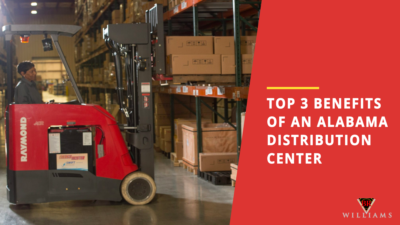
The supply chain crisis created by the COVID-19 pandemic is changing everything. The Financial Times reports a top executive at UPS expects the supply chain crisis created by the pandemic will inflict lasting damage. A global survey of 800 executives by McKinsey also points to significant disruption and change ahead. To understand what’s going on with third-party logistics, we had an extensive discussion with four industry thought leaders at BR Williams.
First, let’s start with the pain points. What challenges are supply chains facing because of the pandemic?
Greg Brown (GB), Chairman/CEO: The pandemic changed global supply chains in two ways: a supply shock that began in China and a demand shock to the global economy due to a worldwide shutdown.
The pandemic exposed a supply shock, our supply chain’s dependence on China for pharmaceuticals, critical medical supplies like KN95 masks, and other household essentials. Combining an ongoing trade war with China and companies’ inability to get products to the global marketplace created intense pressure politically and competitively. Companies dependent on China for manufacturing shut down, with no other options, for what seemed an eternity in today’s world.
People buying much more than they needed exacerbated the demand shock. The hoarding of supplies challenged supply chains. Unable to supply normal loads due to shutdowns, supply chains were nowhere near able to execute excessive demands.
Can you describe the pandemic’s specific impact on BR Williams and its customers?
Christopher Moore (CM), Vice President of E-commerce Fulfillment and Business Development: There’s a struggle to get products into the country. As the pandemic continues to flare up in different regions of the world, manufacturing facilities, suppliers, port facilities, warehouses, and other integral parts of the supply chain pose a threat. Any of these elements can delay or stop the supply chain.
When you combine these threats with a significant increase in demand due to a reduced supply and inflation, companies must fight for what little space is available. As a result, shipping costs more than quadrupled. Once the goods arrive at the port, they experience further delays due to the sheer volume of vessels awaiting to unload. Companies are being forced to think outside of their typical operational footprint to find a way to speed up this process.
How do you implement scalable processes to manage this unpredictable demand?
CM: Diversification in the supply chain is vital here. Companies may need to replicate manufacturing production in various regions or use many ports of entry to speed up delivery to the country. Whatever process they put in place, manufacturers that are agile enough to change strategies will succeed.
As a responsible third-party fulfillment provider, you should also watch what’s going on in the market, locally and globally. Events like weather or political changes within regions can significantly affect the supply chain. These events can and will change a company’s ability to get its product to the end customer.
Let’s switch gears a bit. Have you noticed accelerated growth in e-commerce since the pandemic began?
CM: Yes. Since kicking off our e-commerce fulfillment services, we have seen substantial growth in customer needs and volumes. We’ve also seen requests for our services from new potential customers.
What about the sales process? Was it affected by COVID-19?
CM: Fulfillment sales have always been challenging. It’s one of the reasons I love it so much. COVID-19 changed various aspects of this process, from prospecting to customer interactions.
Traditional cold calling is a thing of the past. Instead, the best way to make yourself discoverable is through Google searches and social media. Using these tools increases your likelihood of companies contacting you for your services.
I wouldn’t have imagined completing an agreement three years ago without at least one in-person meeting. Since COVID, I haven’t had a single in-person meeting before closing. That trend isn’t likely to change anytime soon.
Sales professionals have gone from “dialing for dollars” to becoming trusted experts in their field. You must be ready 24/7 to have business-impacting conversations and provide guidance to help customers. Building solid relationships with prospects and maintaining an ongoing relationship is critical for your organization’s success.
How exactly do you develop and deepen client relations when there are inventory delays?
Phillip Deason (PD), Vice President of Distribution and Warehousing: The supply chain can have delays for many reasons. At BR Williams, we understand late or extended deliveries can wreak havoc on the whole supply chain. We stay in contact with our existing clients to understand their delays and discuss solutions. Sometimes, listening to the client is a large part of the solution.
We conduct customer health checks with existing clients, hearing their needs, concerns, and forecasting. Our current client relationships are the top priority for our warehouse division. Developing new client relationships is a high priority, usually a close second. The best way to achieve the second is to be good at the first.
Government efforts to mitigate the pandemic’s strain seemed to produce unintended consequences. Can you elaborate on their impact on the supply chain?
GB: As governments poured stimulus into the marketplace, they created more demand on already failing supply chains. The stimulus also subsidized unemployment at excessive levels, way past the actual needs. It created labor shortages for regions attempting to return to work.
Thomas Bardwell (TB), Vice President of Logistics: The stimulus and unemployment benefits kept many drivers and potential drivers on the sidelines. This suppressed the market’s response to the shortage despite becoming very healthy and attractive to carriers to expand.
Further exacerbating the problem was the semiconductor shortage. While it did reduce demand, the more significant impact was on class 8 truck manufacturing, constraining truck supply. Demand peaked in late 2020, and orders began to wane as truck prices increased. Carriers were less aggressive in their pursuit of more equipment, given the long waits, inability to seat trucks with drivers, as well as the ambiguity of future market conditions.
As a result, there’s increased demand from the shipper community, needing help with sourcing capacity. Third-party logistics providers (3PL), even BR Williams, have difficulty sourcing the capacity the shipper community needs.
What has BR Williams done to acclimate to changes from the pandemic?
TB: BR Williams has taken many steps to accommodate the increased demand and ever-increasing difficulty in sourcing trucks. We made several key hires to increase our sourcing activity. We identified several areas of our business we could automate:
- Tracking
- Telemetry
- Document creation and retrieval
- Order creation
- Carrier sourcing
- Load tendering
- Billing and settlements
- TMS upgrade packed with efficiencies
- Enhanced customer user interface with better visibility tools
Automation increased the number of loads we can manage at a high level, translating to efficiencies for our customers and us. This, combined with the more team members, allowed us to acclimatize to a high-demand environment with sustained capacity constraints.
We have already experienced tremendous change because of the pandemic. What can we expect as long-term or permanent changes in the future?
GB: Once the global economies work through the stimulus monies, we can expect a global slowdown from these current demand levels. We have already seen inflation almost uniformly due to demand outstripping supply and skyrocketing material and transportation costs. As pressure builds for companies to diversify their risk, companies will experience tremendous pressure to provide standard competitive pricing and source domestically or multi-nationally. No one wants to repeat this experience again.
Political and internal pressures will force companies to build inefficiencies into supply chains. This will create a reality of more global inflation. At the same time, this will compete with companies that ignore the risks and go back to driving costs down through traditional methods.
Independent of COVID, do you foresee changes to how 3PLs operate in the next five years?
TB: There’s tremendous motion in automating processes associated with third-party logistics (3PL) operations and becoming as frictionless as possible. Frictionless, as defined in our industry, means no human interaction. That means the load is tendered from the shipper electronically. The carrier is sourced through an automatic process, tracking the load via ELD/GPS and geofencing and updating it. Problems are identified with AI and machine learning so that the 3PL can manage by exception. Then the load is billed and paid without any manual entries whatsoever. All this occurs with complete visibility and API integration with and for the shipper. Automation will allow 3PLs to manage around 1,000 loads per month per person when fully functional, increasing from 100-150 loads per month per person via conventional means. Within five years, the industry will be around 75% along its journey toward entire frictionless operations.
GB: Most companies are already feeling increased pressure. The smart ones are already building a safety stock of vital manufacturing components and growing inventories, leaving room for potential inefficiencies. We’ll also see a demand for diversification of supplier bases in different countries, a significant administrative and cost burden. Supply chain managers will insist on having risk managers on staff as they’ll need to map complete supply chain vulnerabilities. Companies will also consider refining their offerings. Some will offer fewer models with fewer options to simplify processes and reduce risks. Everyone will be trying even harder to distinguish themselves from their competition going forward.
On a more positive note, what are some of the benefits you see for the future of logistics?
PD: As paper records become a thing of the past, mobile apps will be commonplace at all third-party logistics firms. With the help of RFID-enabled devices, all items will carry their information with them. This will end paper usage to record incoming and outgoing shipments and increase speed, productivity, and accuracy.
Where applicable, we’ll see an increase in the use of artificial intelligence (AI), machine learning (ML), and automation. The old-school process costs a lot of time, money, and labor. For logistics and supply chain companies looking to stay competitive, turning to AI will be a game-changer.
GB: We’ll also see an explosion in 3-D printing and other manufacturing technologies. Pressure will continue to build for more cost-effective and dependable alternatives for traditional manufacturing.
PD: Most e-commerce fulfillment companies have limited locations, making it challenging to deliver same-day or next-day commitments on a national scale. Multi-partnerships will reduce the cost and exposure of purchasing or leasing brick-and-mortar facilities. Companies will need to work with fulfillment companies in other regions to continue growing and acquiring client accounts with one- or two-day shipping requirements.
The Future of Third-Party Logistics
Many factors are driving the current logistics crunch: spikes in consumer demand, disruptions to global shipping, damaged airline industry, soaring container freight rates, clogged ports, and issues sourcing essential supplies. Companies that deal with the changing dynamics in their supply chains will be the survivors and successful companies going forward. Contact BR Williams today to set your company apart with exceptional direct fulfillment services.



